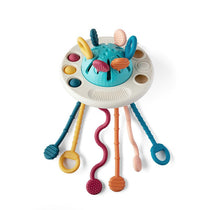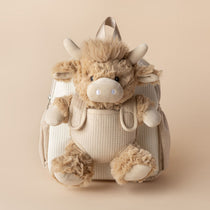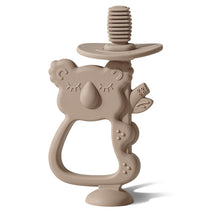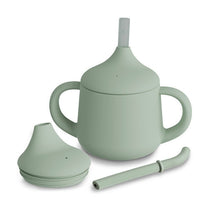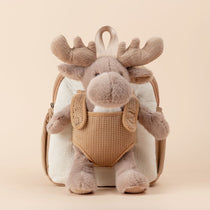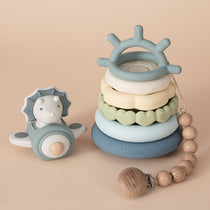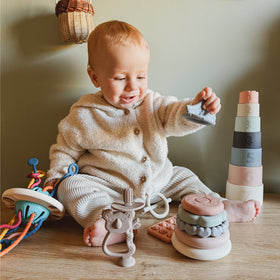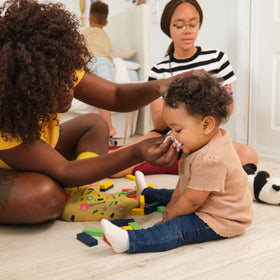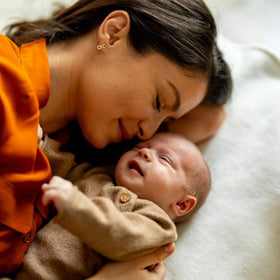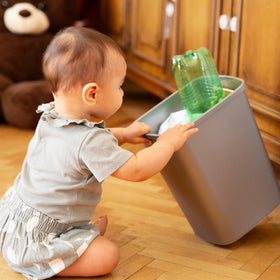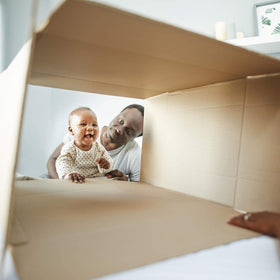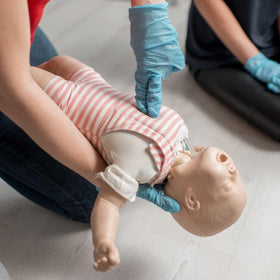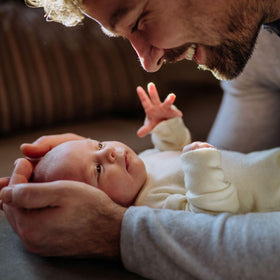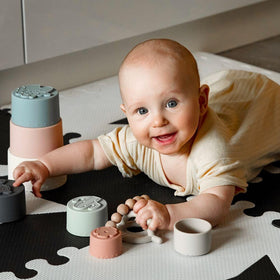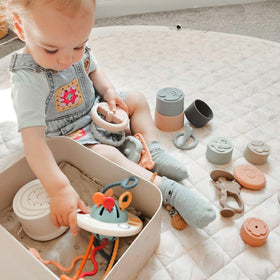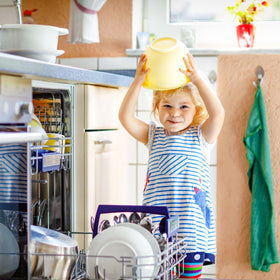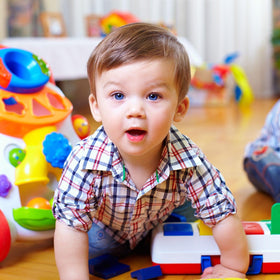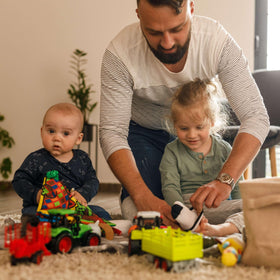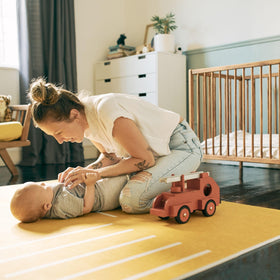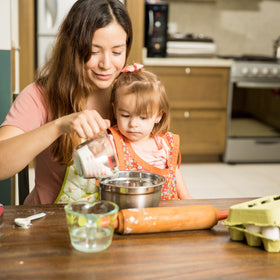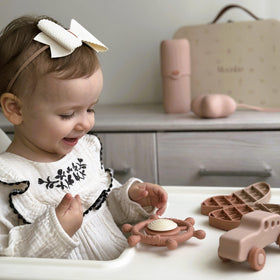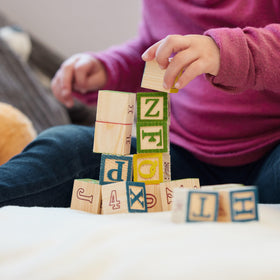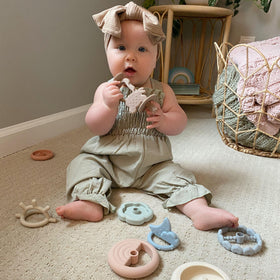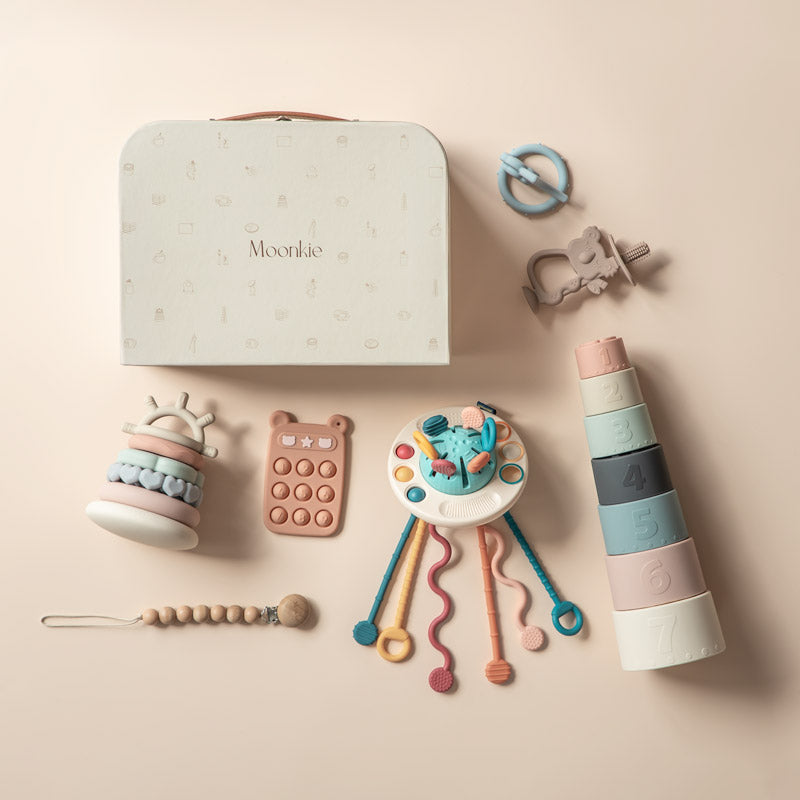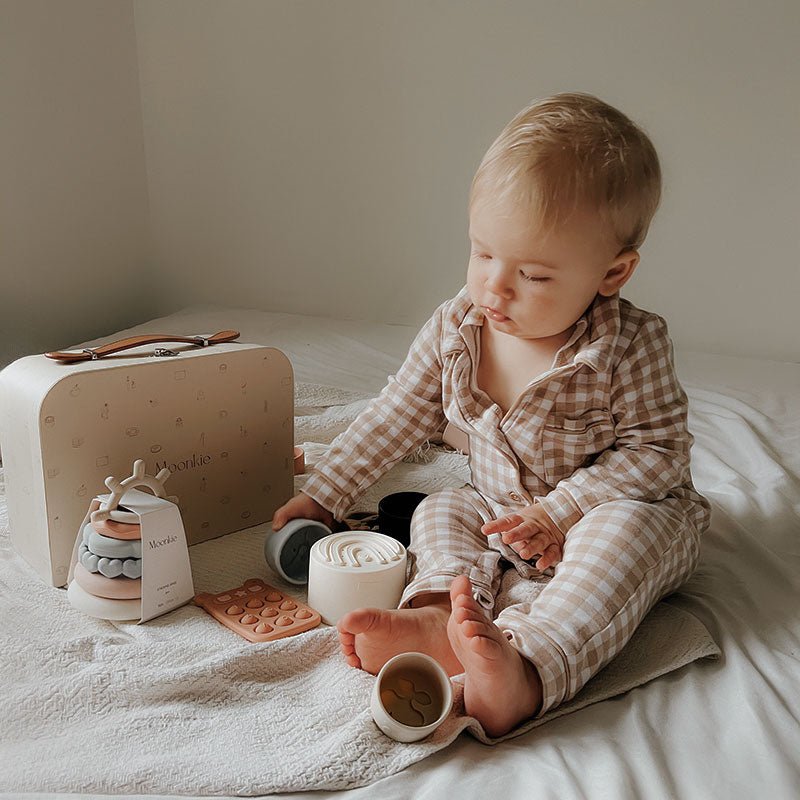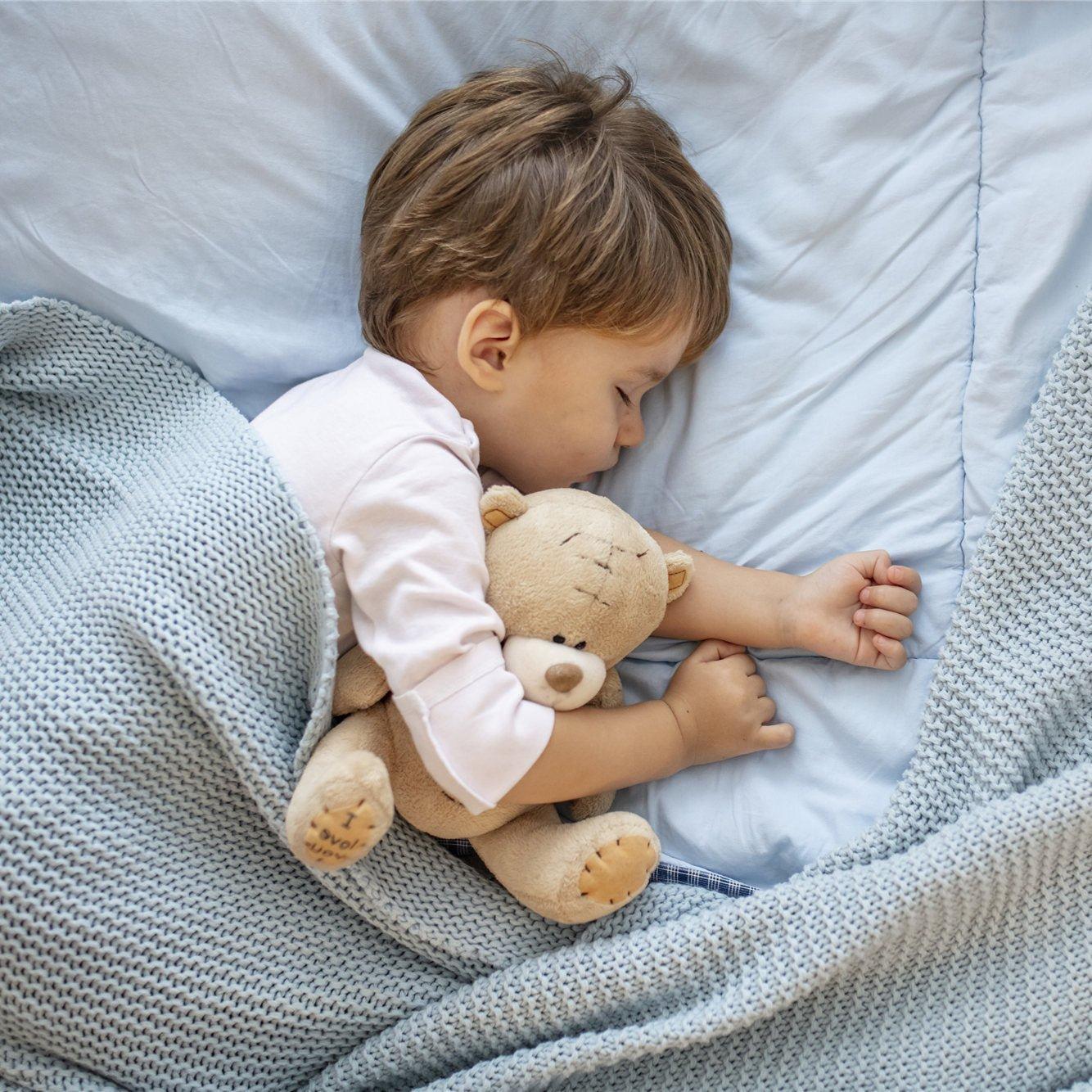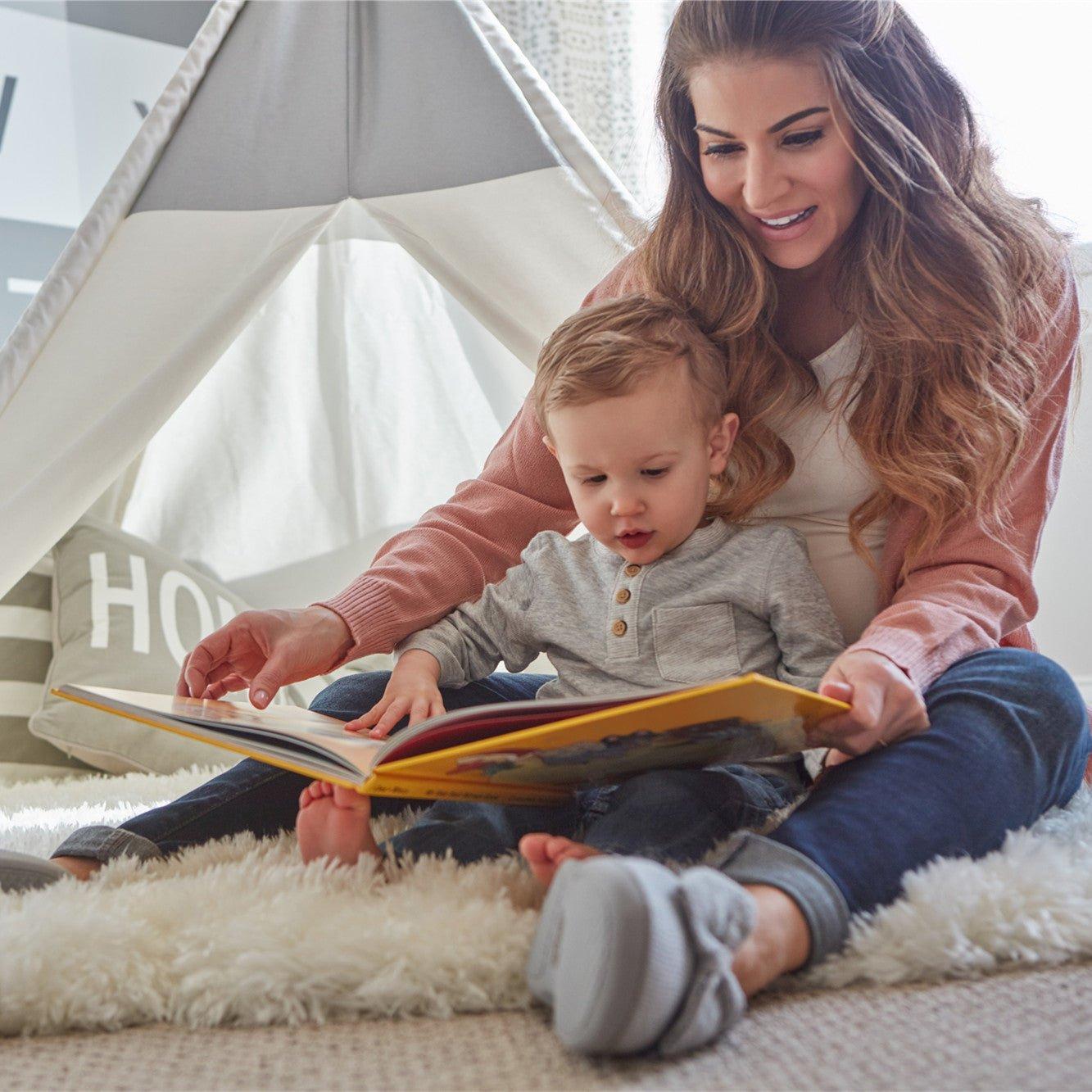You already know that letting your one-year-old on a sleep schedule is crucial for growth and development. But what you may not know is that sleep deprivation in one-year-olds has been linked to behavioral problems, poor cognitive development, and even obesity later in life (source).
According to the National Sleep Foundation, one-year-olds need 11-14 hours of sleep daily, including naps and nighttime sleep (source). However, getting your little one to sleep through the night and take regular naps can be challenging, especially when sick or teething.
We've put together this ultimate guide to help you and your one-year-old get the sleep you both need!
Establishing a Bedtime Routine
One of the most important things you can do to help your one-year-old get the sleep they need is to establish a consistent bedtime routine. And yes, that means doing your best to stick to a consistent time every day.
A study published initially in Sleep Medicine Reviews found that infants and toddlers who followed a consistent bedtime routine had better sleep quality and were less likely to wake up during the night (source). More than that, the same study found that a regular nightly routine promotes broad development and wellbeing in childhood.
The thing is, a nightly routine packed with nurturing, physical care, calming, and undistracted time together is what babies and toddlers need at the end of a busy day. Bedtime routines will look different from family to family. Here is a list of typical bedtime routine activities:
bath time
brushing teeth
healthy bedtime snack
reading bedtime stories
singing or lullabies
listening to an audiobook together
coloring
rocking
talking about the day
playing music
evening walk
sitting outside on a balcony, porch, or sitting area, watching the stars come out
Choose whatever activities work for your family and help your child calm down. Some kids get wound up when outside, while others find it peaceful. Some prefer rocking over listening to music. Do what works for you!
Can I Mix Up Our Bedtime Routine?
Yes and no. Some one-year-olds are flexible with what happens in a bedtime routine as long as the basics, like hygiene and time together, happen. However, some personalities do not handle mixing up bedtime routines well at all, especially in changes of place.
Changes in routine now and then will inevitably happen, such as new places, traveling, staying the night with family or friends, or seasonal changes in how long the sun is up. Ensuring that your little one has two or three things that always happen regardless of where you are or how late you stay up mitigates some stress.
Learning to cope with changes in expectation and being satisfied with what you've got are life skills your little one will have to learn, but expecting him to understand them at one year old is unrealistic. So, ensuring hygiene and one activity always happen is helpful, calming, and realistic while traveling or staying with a family member.
Believe it or not, having a bedtime routine is incredibly helpful as a parent. You know all the things that have to be done, and your toddler soon expects them. Yes, some disobedience will likely happen, but you'll have the standard schedule to set boundaries that your toddler understands more and more with time.
Helping Your One-Year-Old Sleep Through the Night
Many parents struggle with getting their one-year-old to sleep through the night. Generally speaking, it takes a baby three to six months to develop their circadian rhythm. From there, they will gradually sleep more at night and less during the day. But, with a toddler wanting to nap off and on, sleep for you is scarce.
As babies transition into toddlerhood, they tend to become more active while awake. Running around, exploring, discovering, learning, talking, eating---everything! For most little ones, the more they do, the better they sleep (without making them overtired, of course).
Infants and toddlers who go through sleep training may sleep through the night and have fewer awakenings than those who don't undergo sleep training--briefly. You see, sleep training may help for a few months but will likely wear off and need redoing as your little one grows and develops (source).
What Is Sleep Training and Does It Work?
Sleep training refers to several different methods of getting your baby or toddler to sleep. These methods range from gentle parent-camps-next-to-baby methods to old-fashioned let-baby-cry-it-out methods. Most studies on sleep training methods are too small to give solid statistics.
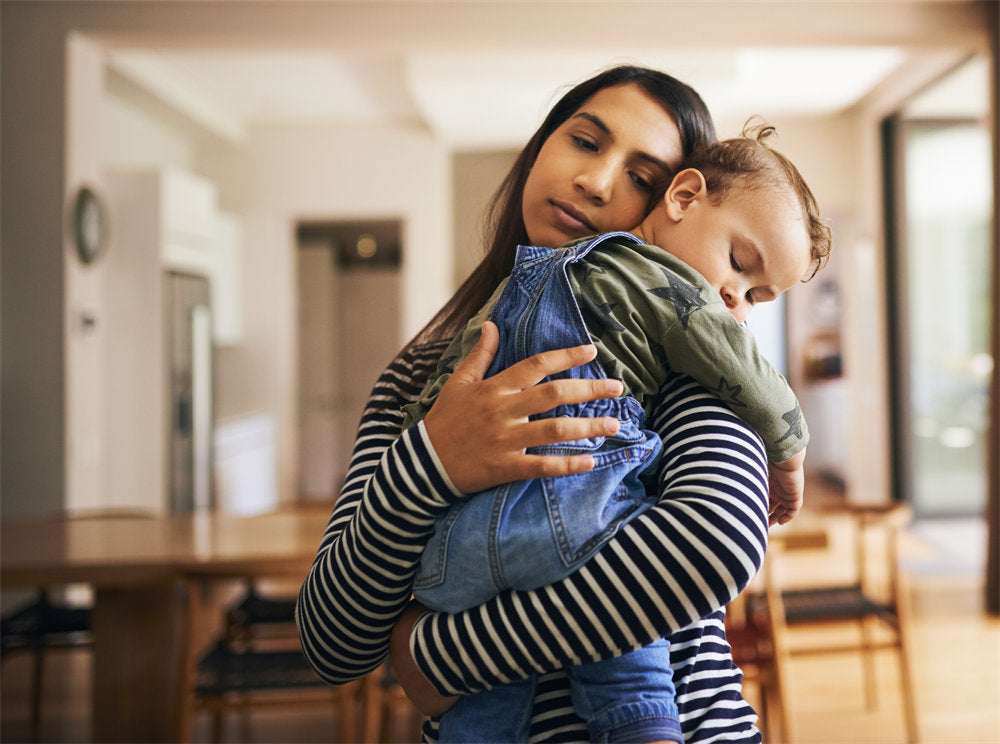
The hurdles to sleep training methodology are family lifestyle, parent-child relationships, and individual personalities and preferences. Some little ones prefer being comforted for a few minutes when they are laid in their crib; others may prefer seeing a parent sitting nearby.
Either way, the goal of sleep training is eventually falling asleep at a predictable time without needing a parent's constant attention and staying asleep throughout the night.
However, as a little one grows, she will naturally go through ups and downs in when she falls asleep, how long she sleeps, how often she wakes at night, and when she wakes in the morning. Sleep training may help regulate swings, but its effects don't last.
5 Common Sleep Training Methods
You can think of sleep training methods as cards in your hand. If one doesn't work well or stops working for your little one, you've got a backup plan as long as you know other methods.
Here are five common sleep training ideas you can try:
Method |
Explanation |
Cry It Out |
|
Ferber Method |
|
Chair Method |
|
Pick Up, Put Down Method |
|
Late Bedtime |
|
If you are concerned about ways to manage all this while traveling, check out Sustainable Traveling with Babies and Toddlers: How to Stay Green on the Go.
How Long Does It Take to Sleep Train My Child?
It depends on your family's lifestyle, routine, method choice, and individual personalities. Sleep training could take four nights or ten. Try the same method for at least a week before shifting to a different one.
Some methods don't work for some babies, but it will take a few nights of consistently trying that method out before you can determine that. Even so, your baby's personality, desires, and sleep habits will evolve as she grows, so you could circle back in a few months to try a method that didn't work at first.
Should I Do Sleep Training At All If It Will Only Work for a Short Time?
Let's face it: sleep training is more for the parents than for the child. The average American household these days doesn't have a village around to help babies and toddlers fall asleep (or help throughout the night), so sleep and sleeplessness fall squarely on the parents' shoulders.
There's no conclusive evidence that sleep training a baby results in an amazingly healthy sleeper later in life. And since the effects wear off within a few months, you could argue that there's no point in putting yourself through the hassle.
However, strong evidence exists for the benefits of having a nighttime routine, as mentioned above. If you are in dire need of sleep and feel like you are at wits end, then doing sleep training every few months may pay off.
Some parents swear by sleep training, while others don't. Science doesn't have enough evidence to support one way or the other. So, try a few different methods to find what works for your family.
How Can I Help My Teething One-Year-Old Fall Asleep?
Teething is where falling asleep becomes a real challenge. You can try adding a few soothing activities your one-year-old enjoys to the end of your nighttime routine and before bedtime.
You could also try giving her a safe teether that you know she cannot choke on or hurt herself with. If you have questions about teether materials and which ones are safest for your little one, read Are Silicone Baby Teethers Safe? What You Need to Know.
When your little one is agitated or hurting due to teething, don't feel bad about hanging onto your baby and rocking her to sleep or letting her fall asleep on you before you lay her down. She's hurting and needs comfort.
Some parents are concerned that this will start a long-standing dependence on being held to fall asleep, but this assumption hasn't been supported in studies.
How Can I Help My Sick One-Year-Old Fall Asleep?
Everything normal gets thrown off by sickness, and how to help your sick one-year-old depends on what's keeping him up. For example, if your little one is not sleeping because he's coughing a dry cough, putting a humidifier in his bedroom along with a chest congestion cream will help.
For copious amounts of snot and sneezing, you can prop one end of your little one's mattress up slightly to keep that mucus draining in addition to whatever medicine your pediatrician prescribed. Furthermore, a camphor and eucalyptus cream for babies and toddlers is helpful.
Some little ones do much better sleeping on a couch or in a recliner because they are not able to lay flat for long while coughing or dealing with mucus problems. Fevers tend to sap a little one's energy, so giving your wee one fever medicine and making him comfortable in a cool room is likely all you will need to do.
What To Do When My One-Year-Old Is Resisting Naps
If your one-year-old is resisting naps, there are a few things you can do to help encourage her to sleep. Toddlers who take regular naps have better emotional regulation and are less impulsive compared to those who don't nap regularly, so it's worth the effort (source)!
Following a consistent nap schedule and sticking to a pre-nap routine are the best things you can do for a wee one determined to power through the day on delirious stubbornness. Don't let her stay up sometimes because you'll only make it more difficult for future naps.
As for what to do in your routine, do whatever suits your daily schedule! The "right way" is what works for you and your one-year-old. Here are some ideas of things you could do in a pre-nap routine; choose two or three (or come up with your own):
lunch or snack
do a nap song and dance
dress down to a diaper and shirt or put on a sleeper
close the curtains
turn on a box fan or sound machine
sing a naptime lullaby
read a naptime book
wash hands and face
pick a naptime stuffed animal
After a few days of a set routine, your little one will begin to understand the naptime signals and start winding down. If she gets stubborn with you, try a sleep training method from the chart above.
Can I Let My One-Year-Old Watch a Video Before Naptime?
Screens before bedtime or naptime are a terrible idea, as screens are not recommended for babies and toddlers under two years old. TV shows, tablet games, phone games, and movies are meant to excite and deliver dopamine hits.
That screen may buy you time to get stuff done, but blue light exposure keeps littles awake longer, too (source). It's just not worth it.
5 Common Myths About Getting One-Year-Olds to Sleep
You've probably heard plenty of advice on how to get your one-year-old to sleep. Is any of it true? By understanding these common myths about one-year-old sleep, you can make more informed decisions about how to help your little one get the sleep they need.

Here are five common myths about getting one-year-olds to sleep:
Myth |
Fact |
Keeping a one-year-old awake during the day will help them sleep better at night. |
In reality, one-year-olds need enough daytime sleep to sleep well at night. Skipping naps or keeping your little one awake during the day can actually make it harder for them to fall asleep at night. |
Letting a one-year-old cry it out will harm them emotionally. |
While it's natural to want to comfort your little one when they're crying, sometimes it's necessary to let them cry it out. A study found that sleep training does not have any negative effects on a child's emotional development (source). As long as your child is safe, unhurt, not hungry, and not sick, letting them self-soothe is acceptable. |
Co-sleeping with a one-year-old is the only way to get them to sleep. |
While co-sleeping can be comforting for both you and your little one, it's not the only way to get them to sleep. With a consistent bedtime routine and a cozy sleep environment, your one-year-old can learn to sleep on their own. |
One-year-olds should sleep through the night without waking up. |
It's normal for one-year-olds to wake up during the night. In fact, most one-year-olds wake up at least once during the night. However, if your little one is waking up frequently or having trouble falling back asleep, it may be a sign that they need a more consistent sleep routine. |
Sleep training is harmful to a one-year-old's development. |
Sleep training can actually be beneficial for a one-year-old's development, but the effects will only last for a few months. Sleep training will have to be redone every so often. |
In a Nutshell
Establishing a sleep routine for your one-year-old may seem like a daunting task, but with the right tips and tricks, it's definitely possible. Two things to remember: 1) the "right way" to sleep train or set up a bedtime/naptime routine is whatever suits you and your child; and 2) you will ultimately win (I mean, "be successful").
There will be some rough nights, but by sticking to a routine, you will nurture your child emotionally, mentally, socially, and physically for future wellbeing. Hang in there; it's worth it!











